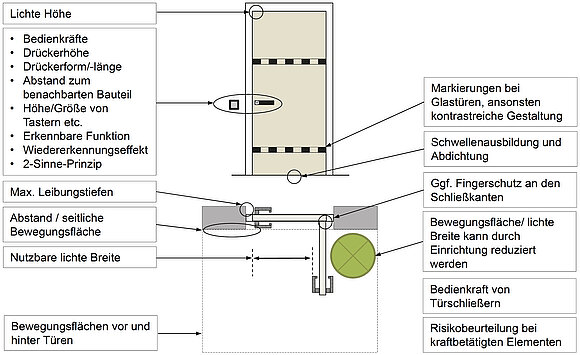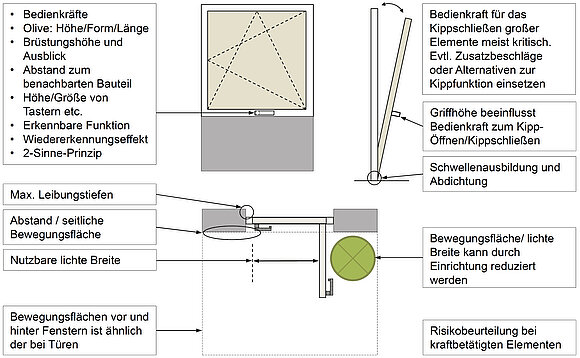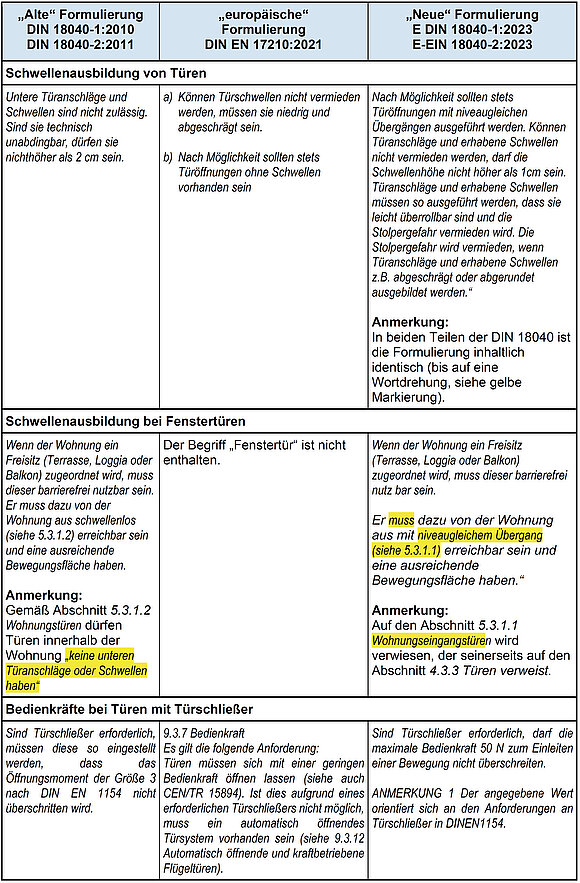Reading time: 6 minutes
Accessibility of buildings is an important feature that is heavily debated in the context of an aging population, inclusion and equality.
The draft of E German-Industrial-Norm 18040 Construction of accessible buildings - Design principles - Part 1: Publicly accessible buildings and Part 2: Dwellings was published with an issue date of February 2023. Although both Parts are mandatory only for new buildings, they are of course also used as a basis for building modernization.
The third part of the series of standards, with the title "Public Traffic black and Open Space", was already presented to the public in January.
These drafts, together with the European standard German-Industrial-Norm EN 17210 published in August 2021, are to replace the respective national predecessor standards. There are no fundamental amendments for the building components windows and doors. However, there are important amendments in specific points that planners, manufacturers, dealers and installation companies should be aware of.
Background of the revision
With the publication of the higher-level German-Industrial-Norm EN 17210 "Freedom from barriers and usability of the built environment - Functional requirements", a revision and/or adjustment of the national German-Industrial-Norm 18040 series of standards became necessary. It should be noted that German-Industrial-Norm EN 17210 primarily formulates protective goals and contains recommendations. Consequently, the functional requirements formulated there are purely qualitative, i.e. without concrete quantitative declarations and therefore difficult for practical applic. More detailed information on German-Industrial-Norm EN 17210 can be found in the ift publication "Freedom from barriers - the new German-Industrial-Norm EN 17210 - Consequences for the national German-Industrial-Norm 18040 series of standards".

What has changed?
In principle, there are only selective amendments and/or additions for windows and doors. The structure (table of contents, illustrations, etc.) has essentially been retained. Some segments - such as 4.3.3.5 "Orientation aids on doors" and also 5.3.2 "Windows" (only in Part 2) - have been adopted with identical wording. The essential requirements for doors and windows and their mounting position (Photo 1 and 2) have also not been changed significantly - with the exception of the declaration on the max. permissible threshold height. As expected, the revision also increased the scope of the standard, which is not surprising, since the European basis German-Industrial-Norm EN 17210 comes with a proud 324 pages.
Many of the normative requirements are not primarily directed at the building components themselves, but at accessibility and reachability. These are determined to a large extent by the positioning in the wall. For example, an additional Photo 6 "Movement areas between door swing areas" has been included that shows the movement areas in a "lock arrangement." As part of this, new footnotes have been added to Table 1 "Geometric requirements for doors". Much of the normative content is design specifications that the manufacturer usually cannot affect, but should be aware of. Ultimately, the construction of accessible buildings is primarily a planning task that should be carried out by specialist planners. The ift technical information BA-02/1 "Recommendations for the transformation of freedom from barriers in residential construction with windows and doors" provides information on this. This publication highlights conflicting goals and practical solutions.


The most important amendments for windows and doors are listed below.
In segment 1, Scope, the wording has been slightly changed compared to the previous standard: "This document is to be used for new buildings. For the design of alterations or modernizations, the document is applicable mutatis mutandis."
We understand this to mean that the protective goals specified in the standards are also to be aimed for in old buildings. However, due to general conditions, in particular structural conditions, this cannot always and everywhere be fully achieved without massive intervention in the fabric of the building. Which of the specifications can be implemented must be decided in each individual case. This decision is basically a weighing up and a search for compromise and should be made with all parties involved (building owner, planner and manufacturer/fitter), if possible.
The segment 3 "Terms" has been significantly expanded - to now 15 terms (in Part 1). For the first time, definitions of the following aspects can now be found here
3.11 Threshold
"Horizontal part at the bottom of the door frame above which the door leaf rests and which separates the floor between two adjacent areas".
[Source: German-Industrial-Norm EN 12519:2019-02, 3.58, modified - Note 1 on term removed]
3.12 Transition at the same level.
"Horizontal transition between two structural levels with a tolerance-related height offset of max.4 mm" and note 1 to the term: "Transition rails and transition profiles are permissible in this context."
Thus, the misleading term "thresholdless" was replaced throughout by "levelled hinge passage" and provided with a tolerance specification.
In addition, the topic of tolerances, which is frequently discussed in practice, was made more specific and reference was made for the first time and by way of example to German-Industrial-Norm 18202 "Tolerances in structural engineering - construction works" (undated). Thus, both parts of E German-Industrial-Norm 18040 contain the following reference in segments 4 and 5:
Segment 4 specifies "Finisheddimensions. Finished dimensions contain tolerances (see e.g. German-Industrial-Norm 18202). Tolerances shall not cause required minimum dimensions to be undercut and maximum dimensions to be exceeded. They must therefore be taken into account in the planning process. Deviations in the construction can only be tolerated insofar as the function intended in this document is achieved."
The finished dimensions referred to are in many latches a sum of several individual dimensions. These usually result from various individual trades with their own specifications and tolerance specifications, which can also add up unfavorably. As a result, it is conceivable that deviations may occur that do not correlate with the barrier-free protective goals. A classic example of this is the declaration of handle height. It is recommended that tighter tolerances and/or higher design accuracies are specified in the planning so that the specified protective goals can be reliably achieved.

Threshold formation of doors
It is already becoming apparent that the discussions will again focus on the wording of the threshold formation and/or its consequences for the design (as in previous rounds of objections). Table 1 compares the wording of the requirements in the various standards experts. If the "new" wording is compared with the "old" wording, it is noticeable:
- The text is significantly longer
- "are not permissible" has been replaced by "according to possibility should".
- The term "thresholdless" has been exchanged for "level".
- Reduction of the exemption for threshold height from 2 cm to 1 cm threshold height, although a precise description of this dimension is not provided.
- Wording "Bottom door stops are not permitted. If they are indispensable for technical reasons..." is replaced by "If door stops cannot be avoided, the threshold height may be ...".
- Term "rollovercapability" and "tripping hazard" included.
- Terms "chamferedor rounded" mentioned, but not clearly regulated
Practice Note on Threshold Height:
In order to counteract the frequent "millimeter discussions" regarding the threshold height and to be able to assign a reproducible value to the formulated protective goals "easy to roll over", ift Rosenheim has published the ift-Guideline "BA-01/1 Determination and classification of the rollover capability of thresholds", which makes it possible to determine and classify the rollover capability. As a result, different sill formations can be objectively compared and quantified in tenders. To avoid discussions or disputes, the purchaser should communicate the technically feasible threshold height prior to the execution of construction and have it approved by the client.
Threshold design for French windows
Floor-to-ceiling French windows (balcony and casement doors) are normatively included in windows. Only Part 2 "Flat" contains specifications for windows. Declarations on threshold formation on French doors are not found in section 5.3.2 "Windows", but in section 5.3.6 "Outdoor seating" (see also comparison in Table 1).
Note:
German-Industrial-Norm does not recognize the term "Frenchwindow".
Due to the amended reference, the same requirements now apply for French windows as for doors and thus also the exemption with up to 1 cm threshold height. Technical indispensability is no longer required and/or must be demonstrated. This makes rebate sealing systems for French windows technically difficult to implement.
It is already becoming apparent that this paragraph will again lead to a large number of objections. This is surprising, since other specifications in the standard can have far more serious consequences in terms of transformation on the building site. This applies in particular to the operational force and the resulting requirement for equipment with drives and any necessary safety measures. At this point, it should be clearly mentioned that the normative requirements for doors are extensive, running to approx. 4.5 pages, and that threshold height is only one aspect illustrated.
Operational forces for doors with door closers
There has also been an amendment and/or specification with regard to the permissible operating forces and/or torques. This is because the specification for the operational force to initiate movement has been formulated more clearly in the form of a maximum force of 50 N (corresponds to Class 2 according to German-Industrial-Norm). Unfortunately, the force initiation point is not clearly formulated. The associated test standard EN 12046-2 is currently being updated.
Outlook - What's next?
The 36-month deadline for revising the national German-Industrial-Norm 18040 series of standards ends at the beginning of 2024. As a result, the objections must be processed and the three parts of the standard published by then. Due to the expected large number of objections, this will be a major challenge for the responsible standardization committee.
Literature
- E-German-Industrial-Norm 18040-1 - Construction of accessible buildings - Design principles. Part 1 Publicly accessible buildings. Beuth Verlag GmbH, Berlin 2/2023
- German-Industrial-Norm EN 17210:2021-08 - Freedom from barriers and usability of the built environment - Functional requirements; German-Industrial-Norm version EN 17210:2021. Beuth Verlag GmbH, Berlin.
- ift technical information BA-02/1 "Recommendations for the transformation of freedom from barriers in residential construction with windows and doors", ift Rosenheim, Rosenheim10.2018, ISBN: 978-3-86791-425-3.
- Research report: "Assessment of freedom from barriers in construction elements using windows and doors as examples of application", ift Rosenheim, Rosenheim 06.2018.
- German-Industrial-Norm 18202:2019-07 - Tolerances in structural engineering - Construction works. Beuth Verlag GmbH, Berlin 7/2019
Header image: © Jenny Sturm - stock.adobe.com






